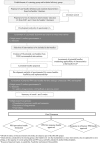Postpartum hemorrhage care bundles to improve adherence to guidelines: A WHO technical consultation
- PMID: 31709527
- PMCID: PMC7064978
- DOI: 10.1002/ijgo.13028
Postpartum hemorrhage care bundles to improve adherence to guidelines: A WHO technical consultation
Abstract
Objective: To systematically develop evidence-based bundles for care of postpartum hemorrhage (PPH).
Methods: An international technical consultation was conducted in 2017 to develop draft bundles of clinical interventions for PPH taken from the WHO's 2012 and 2017 PPH recommendations and based on the validated "GRADE Evidence-to-Decision" framework. Twenty-three global maternal-health experts participated in the development process, which was informed by a systematic literature search on bundle definitions, designs, and implementation experiences. Over a 6-month period, the expert panel met online and via teleconferences, culminating in a 2-day in-person meeting.
Results: The consultation led to the definition of two care bundles for facility implementation. The "first response to PPH bundle" comprises uterotonics, isotonic crystalloids, tranexamic acid, and uterine massage. The "response to refractory PPH bundle" comprises compressive measures (aortic or bimanual uterine compression), the non-pneumatic antishock garment, and intrauterine balloon tamponade (IBT). Advocacy, training, teamwork, communication, and use of best clinical practices were defined as PPH bundle supporting elements.
Conclusion: For the first response bundle, further research should assess its feasibility, acceptability, and effectiveness; and identify optimal implementation strategies. For the response to refractory bundle, further research should address pending controversies, including the operational definition of refractory PPH and effectiveness of IBT devices.
Keywords: Aortic compression; Bimanual compression; Intrauterine balloon tamponade; Non-pneumatic antishock garment; Obstetric hemorrhage; Patient care bundles; Postpartum hemorrhage; Tranexamic acid; Uterotonics.
© 2019 The Authors. International Journal of Gynecology & Obstetrics published by John Wiley & Sons Ltd on behalf of International Federation of Gynecology and Obstetrics.
Conflict of interest statement
The authors have no conflicts of interest. SM received funds from Blue Fuzion. JMS received grants from USAID during the study. The views expressed in the study do not necessarily reflect the views of the WHO, USAID, or the US Government.
Figures
References
-
- Vogel JP, Outcome of the management of massive postpartum hemorrhage using the algorithm “HEMOSTASIS”Oladapo OT, Dowswell T, Gülmezoglu AM. Updated WHO recommendation on intravenous tranexamic acid for the treatment of post‐partum haemorrhage. Lancet Global Health. 2018;6:e18–e19. - PubMed
-
- Berg CJ, Harper MA, Atkinson SM, et al. Preventability of pregnancy‐related deaths: Results of a state‐wide review. Obstet Gynecol. 2005;106:1228–1234. - PubMed
-
- American College of Obstetricians and Gynecologists District II . Maternal Safety Bundle for Obstetric Hemorrhage. 2015. https://www.acog.org/-/media/Districts/District-II/Public/SMI/v2/HEMSlid.... Accessed January 2, 2018.
-
- Goffman D, Nathan L, Chazotte C. Obstetric hemorrhage: A global review. Semin Perinatol. 2016;40:96–98. - PubMed
-
- Lappen J, Seidman D, Burke C, Goetz K, Grobman W. Changes in care associated with the introduction of a postpartum hemorrhage patient safety program. Am J Perinatol. 2013;30:833–838. - PubMed
MeSH terms
Grants and funding
LinkOut - more resources
Full Text Sources
Medical
Miscellaneous


